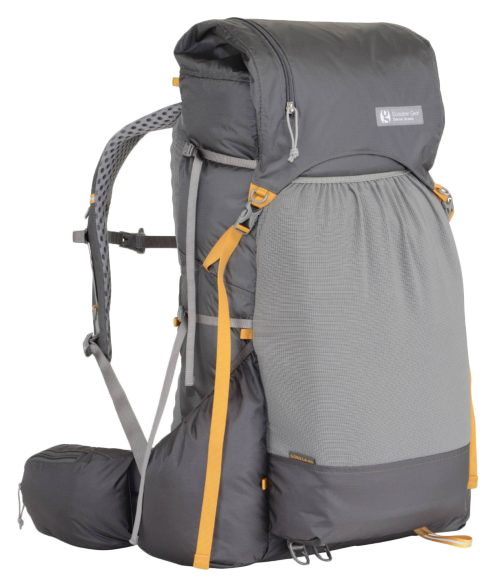Food is probably the most important thing in the entire world when you’re on the trail. By the fourth week of your hike, thoughts of food will take up a good portion of your daily thought. You’ll dream about food while on the trail. Seriously.
Your food for the trip will probably be your largest single expense, and your food choices will have a big impact on how much you enjoy your trip. There is no one way to plan for your food needs on the PCT. Everyone does it differently. But there are many little pieces of wisdom you can follow to be sure your food experience on the trail is a positive one.
The Basal metabolic rate requirement of food calories is approximately 1,000 per day per 100 pounds of body weight. This means you need to eat about 1,000 calories per 100 pounds of body weight per day to survive without losing weight under normal conditions. But hiking is very strenuous work, so you’ll need to consume a LOT more calories. The standard US Army field ration is 4500 calories per day for strenuous work. The usual recommendation for thru hikers is 3,000 to 6,000 calories per day depending on your body weight and pack weight. A 120 pound ultralight hiker may get by happily on 3,000 calories per day, whereas as 200 lbs hiker that carries a 60 pound pack may need closer to 6,000.
To get enough calories without making your pack too heavy, you may want to pay attention to the calorie density of your food (the number of calories per ounce). A good goal is to try to keep most of your food above 100 calories per ounce. This way you’ll be carrying only about 1.5 – 3.8 pounds of food per day (depending on your weight, miles per day, appetite, etc). Always overestimate how much food you’ll eat. Worst case scenario: you bring too much food and have to give some of it away to another thru hiker — thereby winning a friend for life.
When talking about backpacking food, the word “fresh” is used loosely. “Fresh”, in this sense, simply means not dehydrated or freeze dried. Here are some fresh ingredients that are good on a thru hike:
Then there are the various candies and junk foods that also fall under this category. Here are some good examples of those that we recommend for thru hiking:
“Fresh” foods tend to be heavier than freeze dried, dehydrated, and powdered foods. But remember, variety is key: you’ll long for these fresh goodies. Also, keep in mind that some of these sweets melt, so you’ll want to avoid carrying them on the hotter sections of the trail.
Freeze dried food is the lightest food option you’ll find. The taste is good, and the texture is usually better than dehydrated food. They also store longer than dehydrated food. The catch is, freeze dried food is expensive.
You can get good deals buying in bulk online. You can check eBay.com or Amazon.com for bulk freeze dried food and get some pretty good deals. We recommend sticking with the big brands: Mountain House, AlpineAire, Natural High, or Honeyville. Eating freeze dried for every meal of every day may be going overboard. The texture will get old, even if you eat different flavors. But freeze dried food products, such as Mountain House, make a good addition to a varied thru hiker meal plan. When you buy the freeze dried food in pouches, remember that the “2 serving” pouches will only serve 1 hungry thru hiker.
One good idea is to get a bunch of freeze dried ground beef and add it to your meals. It’s a great way to add both calories and flavor to your meals.
Dehydrated foods are cheaper than freeze dried food. They also have a much different texture, so you’ll get more variety. Items like powdered butter can be sprinkled on any meal as a quick way to add calories.
A minority of thru hikers will hike the entire trail without ever cooking a single meal. All of their meals are “no cook”. This saves them a lot of weight (they don’t have to carry a stove, pot, or fuel). They also save a lot of time, as they can just eat their food without cooking it.
Most hikers cook at least some of their meals. But cooking all of your meals may become tiresome after a while. You’ll have to decide for yourself how often you’ll cook, and how often you’ll eat “no cook” meals. Most hikers cook half or fewer of their meals. For example, they may cook breakfast and dinner, while lunch and snacks are “no cook”.
You may find it surprising that most food that hikers cook can be eaten without cooking it. For example, you can add cold water to freeze dried food and toss it in your pack, it will be reconstituted and ready to eat in about an hour. That being said, there is something uplifting and rewarding about eating a nice hot meal after a long days hike.
We’ll take a look at some of your resupply options, talk about the pros and cons of each, and help you decide which resupply option is right for you.
Read MoreLearn how to combine the right sleeping bag, sleeping pad, and ground cloth to create the perfect sleeping system to stay warm and toasty on the trail.
Read MoreCut the cost of your hike, bring in more money at home, and cut your at-home costs so you can save up for the hike you've been dreaming of.
Read MorePlan Your Hike is reader supported. When you buy through links on our site, we may earn an affiliate commission.

Are you all set on gear for the Pacific Crest Trail? Check out our Ultimate Gear Guide for the PCT ->